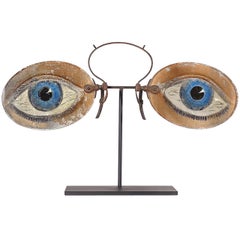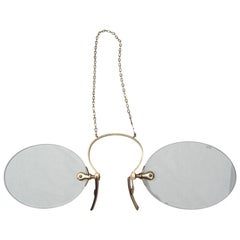Folk Art Spectacles
Recent Sales
Antique Late 19th Century American Industrial Signs
Glass
Early 20th Century Signs
20th Century American Folk Art Decorative Art
Tin
Finding the Right Signs for You
Vintage and antique signs are popular collector’s items loved not only for the charm and pops of color they add to a space but also for the unique story each one has to tell. An interesting sign can help set the mood for a room and spark dozens of lively conversations.
Before and during the 18th century, many European peasants and colonists in the Americas couldn’t read, so shopkeepers, in an effort to promote their goods and services, hung trade signs with limited amounts of text.
Indeed, symbols and representational physical objects comprised early-day advertising efforts. In lieu of painted words on a wooden board, trade signs made use of handmade three-dimensional symbols to indicate the function of the shop. The iconic red, white and blue pole could be found outside barbershops, while a figural trade sign mounted to an apothecary’s storefront might be a mortar and pestle sculpted from bronze in order to indicate to passers-by that inside there were apothecary cabinets full of remedies for common ailments and a druggist to carefully dispense them.
As literacy rates improved, signs evolved into rectangular, round or square shapes that featured text. Short and sweet, early iterations were characterized by a mere few words, such as “tavern,” “boarding room” or “apothecary.”
During the 19th century, proprietors endeavored to render their signs more appealing. This meant the introduction of more color, font types and other pictorial representations. After the Civil War ended, logos, branding and advertising became increasingly more important, and the design of signage evolved. Trade signs were still in use during the 20th century, and you will likely find hand-painted tin eyeglasses for an optometrist’s office or an oversize bowling pin that likely had a home in the front window of a bowling alley.
Today, collectors and art aficionados alike collect and display antique and vintage signs. Old signs hearken back to a long-gone era, infusing any interior with warmth and nostalgia.
A vintage sign can help anchor a room — think of decorating with signs as you would arranging any kind of wall art. A large-scale sign in particular can prove a distinguishing feature in a living room or dining room, a focal point so prominent that it might lessen the burden of introducing any additional decorative elements to this particular space. Smaller signs work wonders too — pepper sparsely decorated corners with small colorful signs or add a humorous or graphic element to your gallery-style hang with a small text-based sign or two.
On 1stDibs, find metal, wood and glass antique and vintage signs that span a number of styles, including mid-century modern, industrial and folk art.
- Is mandala art folk art?1 Answer1stDibs ExpertApril 22, 2024Yes, mandala art is folk art. The definition of folk art is art that reflects the sociocultural characteristics and values of a particular group of people. Mandala art fits this definition due to its association with the Hindu and Buddhist faiths. On 1stDibs, explore a selection of folk art from some of the world's top sellers.
- 1stDibs ExpertSeptember 25, 2019
Among the materials used in folk art are cloth, wood, paper, clay and metal.
- 1stDibs ExpertApril 5, 2022Mexican folk art can be characterized by vibrant colored paintings and jewelry designed with floral motifs. Lush forests and animals, especially birds, are featured in Mexican folk art, which is a blend of Indigenous and European methods and skills. You’ll find a variety of Mexican folk art from some of the world’s top sellers on 1stDibs.
- 1stDibs ExpertOctober 7, 2024The difference between fine and folk art comes down primarily to function. Fine artists produce paintings, prints, sculptures and other artworks to express an idea or concept, communicate a message or tell a story. With folk art, artists are usually more interested in following cultural traditions than self-expression. Pieces of folk art often have more practical uses compared to works of fine art, such as quilts and furniture. Other examples of folk art include pottery, masks, textiles and carvings. On 1stDibs, shop a collection of fine and folk art.
- 1stDibs ExpertSeptember 23, 2024What Ukrainian folk art is called depends on its medium. Named after the village from which it emerged, Petrykivka is a type of decorative painting that often features colorful flowers and birds against a white background. The name for decorating eggs is pysanky, and vyshyvka is the term for decorative embroidery. Explore a large selection of folk art on 1stDibs.
- 1stDibs ExpertApril 5, 2022Jamini Roy was an Indian artist whose paintings often reflected his Indian roots. Roy combined imagery from Indian folk art with Western motifs to create his unique modern works. Subjects ranged from paintings of legendary figures to everyday life in rural Bengal. His goal was to make art affordable to everyone. Browse a selection of Jamini Roy paintings on 1stDibs.
Read More
A Giant Wedding Cake Has Us Looking at Portuguese Tiles in a New Light
At Waddesdon Manor, artist Joana Vasconcelos has installed a three-tiered patisserie inspired by the narrative tile work of her homeland. We take a look at the cake sculpture and how Portuguese tiles have been used in architecture from the 17th century to today.
Why Jules Chéret Was the King of the Modern Poster
The streets of fin-de-siècle Paris were set aglow with colorful poster ads, thanks to the printing techniques invented by Jules Chéret. Now, the Milwaukee Art Museum is celebrating this undersung talent in America's first solo show dedicated his exuberant works.
Why the American Flag Has Had So Many Different Star Patterns
Expert Jeff Bridgman explains the history and meaning behind the twinkling constellations that have graced Old Glory.
Peggy Guggenheim Loved Modernism, but She Also Collected Tribal Art
The iconoclastic style setter displayed African and Oceanic art, as well as works by indigenous peoples of the Americas, alongside pieces by such major modernists as Pablo Picasso and Jackson Pollock.
The 13-Star American Flag Had More Variations Than You’d Think
Perfect for July 4th weekend, a new show at Philadelphia's Museum of the American Revolution displays an array of antique red, white and blue flags.
Tramp Art, America’s Most Misunderstood Art Form, Is Trending in Interiors
Designers are beginning to see this enigmatic form of folk art in a whole new light.

